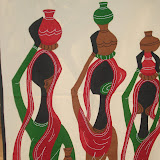Ash outside a typical Tamil Nadu residential colony at Dakshinachitra.
A basket weaver's tenement recreated at DC.
The Kottayam Achayan outside a typical Syrian Christian house from Kerala.
Vaalpayattu (swordfight) in the evening by artists from Kannur, Kerala.
****
Yesterday after church (we finally managed to make it for the morning mass as a family, and not just the Lord of the House making his weekly attendance), V suggested that we go to Dakshinchitra (http://www.dakshinachitra.org/ is the website address they give on their brochure but it is going up the wrong link) won the Mahabalipuram route. It had been on our 'list of places to see' like Mahabs itself.
After cooling our systems with tender coconut water on the way and promising ourselves that we will get a few plant saplings from the numerous nurseries en route, we went past the Toll Plaza on the East Coast Road with the sea on the left and the many entertainment parks - MGM Dizee World, the veteran VGP Golden Beach, etc - on the right. The sprawling, pristine and tranquil DC was an ideal destination to get away from the bustle of city life. Artisans from Orissa, Rajasthan and of course the South Indian states - the place promotes the culture and crafts of India with emphasis on the four Southern Indian states - displayed their wares at the bazaar inside, which they said were very reasonably priced compared to the shops outside or even the craftshop at the reception area. Being Onam (my state festival) time, the reception and the Kerala houses had pookalams (flower arrangment on the floor).
The Kerala and Tamil Nadu sections were the best. Well, the Karnataka and Andhra sections are not complete and we did not visit them. A quick tour of the first two itself took us over 4 hours.
The Kerala houses brought back memories of my childhood - the granaries, the kitchen & farm implements, the cow shed ... The Syrian Christian house relocated from Trichur was so carefully conceived - right up to the picture of Jesus. The 2-storeyed Hindu house was a novelty for me. I followed Ash as he climbed up the wooden stairs, and surveyed the area through the kilivaathil (= bird's door). Climbing down those narrow steps was more difficult - wonder how people did it on a regular basis in those days. Most of the artefacts on display had a "Dont touch, fragile" warning - they all belonged to the 19th century and early 20th century.
The Tamil Nadu section had a Tirunelveli brahmin colony, a Chettiar house, and houses of a farmer, a potter, a basket maker and a weaver. I even got to see a Kanchuipuram silk sari being weaved. The temple atop a small hill was the perfect culmination for the tour. There were not many visitors on that route and so it had the required peaceful ambience.
V bought 2 paintings for framing, while I got a Ravi Varma print, before settling down on the lawn near the reception to watch Kerala artistes at Vaalpayattu, Kalaripayattu and Velakali. Ash was extremely thrilled by the show and was seen somersaulting once the artistes left the stage. I think he has an artistic streak about him.
We had a late lunch and proceeded to Mahabs to view the Shore Temple and other masterpieces in stone. However, we had to head back as the Temple was closed by 5.30 p.m. The Mahabs wonders come under the Archaeological Survey of India, and govt. operated tourist spots close at 6 p.m. the latest.
IT was dark when we drove back and too late to buy the plants. V promised we will come another day. In fact we had come wanting to see the Cholamandalam artists' village but missed it and went to Dakshin. Anyway, we had no regrets - it was a Sunday well spent and the kids had had a lovely time.
 |
| dakshinach |






3 comments:
Sounds like you had a nice day.
beautiful place, nice pics - I like them .. sounds like an idea from USA - here they even have them cooking stuff and keeping it on display... and also chairs/ etc and live people dressed and doing stuff like history. they even have live animals, farm, they do milking/harvesting etc.. even making implements. have guides also.
how much do they charge for entering the village. the place is beautiful... must be Rs 100 odd?here it was some $10-odd person i think.. or fly membership of yr..
how do they maintain it - with selling the stuff they make?
all nice pics.
The madras craft foundation, which runs the non-profit project takes a donation of Rs. 50 from Indians and $10 or so (dont remember) from foreigners. They ask us not to litter,like when we had icecreams.
They have activities like classes in pottery, rice grinding, kolam and a lot many other dying crafts. I think there is a small fee for that. Also palm reading and stuff. Then folk dance class, and other traditional art forms.
There are guest houses at affordable rates.
Yes, they had cooking stuff, ancient cots, chairs, cloths used in those days. Dont remember all now. Saw the supervisors in the KErala area walking around in KErala sari.
Post a Comment